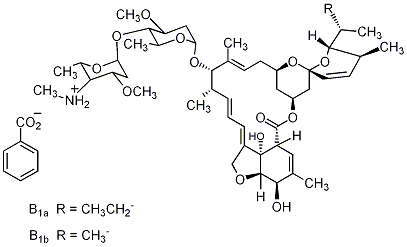Welcome to Union-agrochemCrop Protection Technology (Shanghai) Co.,ltd
Toggle Navigation

NOMENCLATURE
CAS RN [155569–91–8], formerly [137512–74–4] and [179607–18–2]
PHYSICAL CHEMISTRY
Composition A mixture of emamectin B1a (≥90%) and emamectin B1b (≤10%), as their benzoate salts. Mol. wt. 1008.3 (B1a); 994.2 (B1b) M.f. C56H81NO15 (B1a); C55H79NO15 (B1b) Form White to off-white powder. M.p. 141–146 °C V.p. 4 × 10-3 mPa (21 °C) Kow logP = 5.0 (pH 7) Henry 1.7 × 10-4 Pa m3 mol-1 (pH 7, calc.) S.g./density 1.20 (23 °C) Solubility In water 0.024 g/l (pH 7, 25°C). Stability Stable to hydrolysis at pH 5, 6, 7 and 8 (25 °C). Photodegrades rapidly. pKa 4.18 (acidic, attributed to benzoate counter ion), 8.71 (basic, calc., attributed to emamectin moiety)
APPLICATIONS
Biochemistry Acts by stimulating the release of γ-aminobutyric acid, an inhibitory neurotransmitter, thus finally activating chloride channels. Mode of action Non-systemic insecticide which penetrates leaf tissues by translaminar movement. Paralyses Lepidoptera, which stop feeding within hours of ingestion, and die after 2–4 days. Uses For control of Lepidoptera on vegetables, brassicas, fruit, maize, tea, grapes and cotton, at up to 16 g/ha, and in pine trees, at 5–25 g/ha. Formulation types EC; SG.
ENVIRONMENTAL FATE
Animals Emamectin benzoate is partially metabolised but rapidly cleared (DT50 following oral dosing 34–51 h), indicating that it has no potential for bioaccumulation. Plants Metabolism has been investigated in lettuce, cabbage and sweetcorn. It is non-systemic, and rapidly degrades in sunlight to various complex residues in which undegraded parent is the only significant residue. The residues were very low. Soil/Environment Rapidly degraded.
MAMMALIAN TOXICOLOGY
Oral Acute oral LD50 for rats 56–63 mg/kg. Skin and eye Acute dermal LD50 for rats >2000 mg/kg. Not irritant to skin; severe eye irritant. No sensitising potential. Inhalation LC50 (4 h) for rats >1.05–0.66 mg/l. NOEL (1 y) for dogs 0.25 mg/kg b.w. ADI 0.0025 mg/kg. Other Not tumorigenic. Toxicity class WHO (a.i.) II (company classification).
ECOTOXICOLOGY
Birds Acute oral LD50 for mallard ducks 76, bobwhite quail 264 mg/kg. Dietary LC50 (8 d) for mallard ducks 570, bobwhite quail 1318 ppm. Fish LC50 (96 h) for rainbow trout 174, sheepshead minnows 1430 μg/l. Daphnia LC50 (48 h) 0.99 μg/l. Bees Toxic to bees. Worms LC50 >1000 mg/kg dry soil. Other beneficial spp. Safe to a wide range of beneficial insects, due to rapid breakdown of the a.i., limiting contact activity to <48 h.